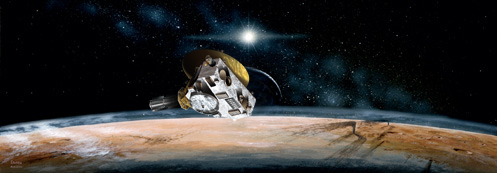As a boy, I recall paging through an old, nine-volume encyclopedia we kept on a livingroom shelf. Published some time in the 1920s, it was hopelessly out of date from a science standpoint, and I remember reading its entry on the planets and feeling, with the smug certainty of youth, that my modern world (this was the late 1950s) had now figured out most of the puzzles still unsolved by the editors. The editors, after all, hadn’t known about Pluto, but we did, and Pluto’s discovery surely meant that the mapping of the Solar System was complete.
Youthful smugness has a way of being brought up short by events, and so do astronomical depictions of things we’ve seen imperfectly. Today we know that Pluto itself is one of what may be a vast number of ‘ice dwarfs,’ a kind of planet probably numerous in the Kuiper Belt. Sedna and Quaoar are members of this class, as is, evidently, Neptune’s moon Triton and the newly discovered 10th planet, still known officially as 2003 UB313. Indeed, according to Alan Stern, principal investigator for the New Horizons Pluto mission, we’ve only catalogued about 2 percent of the Kuiper Belt and have already found over a thousand of these remote objects in their distant elliptical orbits.
Stern, who checks in every month at the New Horizons Web site with thoughts on the mission’s progress, paints a picture of planetary formation that’s a long way from what showed up in my ancient blue encyclopedia. As the giant planets formed, hundreds to thousands of smaller worlds also emerged, some Pluto sized, some larger than Earth. Most of these dwarf planets were ejected into much more distant orbits as the gas worlds cleared out their formation zones some four billion years ago.

Image: The New Horizons spacecraft during its encounter with Pluto and Charon. Scientists hope the spacecraft will make at least one flyby of a Kuiper Belt object beyond Pluto’s orbit. Credit: Johns Hopkins University Applied Physics Laboratory/Southwest Research Institute (JHUAPL/SwRI).
Consider the clues: Pluto’s moon Charon was evidently formed from an impact with an object nearly as large as Pluto itself. Triton circles Neptune in a retrograde orbit that indicates gravitational capture, an ice dwarf that avoided ejection into the outer system. Uranus and Neptune both exhibit pronounced polar tilts, the mark of collisions with Earth-sized bodies and up. Stern believes that for such collisions to have occurred, as many as a few dozen Earth-sized worlds must once have populated the outer regions of the Solar System.
Thus an entirely new paradigm emerges. Here’s Stern:
Less than two centuries ago it was discovered that all the stars one can see by eye, and their innumerable brethren seen by telescope, are distant Suns, with numbers too great to count. Similarly, it was just under a century ago that our galaxy, the Milky Way, was realized to be but one of literally billions of galaxies. Both of these realizations, like the 16th century realization that the Sun (not Earth!) is the center of our solar system, jarred perceptions and changed textbooks in revolutionary ways. Just as jarring to us now is the newly emerging view that our solar system made, and is still littered with, very many distant planets, most of which are nothing like the familiar planets that orbit close to the Sun, like Earth. In a real sense, we are seeing a new chapter unfold in the revolution that Copernicus wrought when he displaced the Earth from the center of everything.
So the strange worlds in their distant, highly elliptical orbits seem to be the norm, and the well-ordered Solar System we all grew up with gives way to a planetary system that may extend out a thousand times farther than Pluto. All of which is ample material for the New Horizons mission as it pushes past Pluto into the Kuiper Belt, and a salutary reminder that just when we start to feel confident, even comfortable in our worldview, new data may just turn everything upside down.
Stern’s most recent “PI’s Perspective” column is here.

